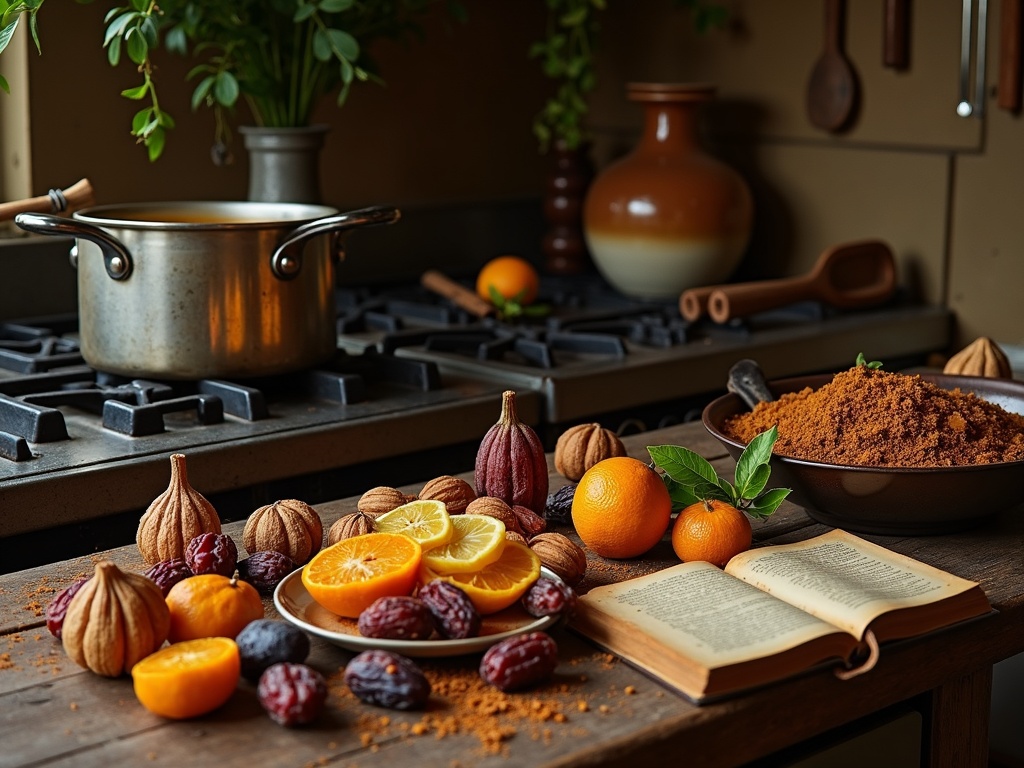Panforte, a medieval Italian confection from Siena, has stood the test of time as a holiday favorite with its dense, chewy texture and rich spice profile. This “strong bread” once functioned as currency and tax payment in medieval times, blending exotic spices with local honey, nuts, and dried fruits to create a luxurious dessert that remains central to Italian culinary traditions.
Find In This Article
Key Takeaways
- Panforte features a distinctive blend of toasted nuts, candied citrus, dried fruits, honey, and warm spices like cinnamon, nutmeg, and cloves.
- This dense Italian specialty has earned protected status as “Panforte di Siena IGP,” ensuring authentic production methods are preserved.
- The treat’s impressive shelf life of several months made it valuable historically and makes it ideal for holiday gift-giving today.
- Traditional preparation involves creating a honey-sugar syrup that binds the ingredients together, requiring precise temperature control.
- Panforte’s flavors actually improve with age, developing more complexity when stored properly for at least a week before serving.
The Sweet History of This Italian Holiday Treat
Panforte traces its origins to medieval Siena, Italy, where this dense, chewy confection first emerged around the 13th century. I’ve discovered that its name literally translates to “strong bread,” referring to both its sturdy texture and potent spice profile. This special treat has remained remarkably consistent through the centuries, maintaining its status as a beloved fixture on Italian holiday tables.
Medieval Roots in Siena
Siena’s spice merchants played a pivotal role in panforte’s development. During the Middle Ages, these traders had access to exotic ingredients like black pepper, cinnamon, and nutmeg from far-flung trading routes. The combination of these rare spices with local honey, nuts, and dried fruits created a luxurious confection that stood apart from everyday fare.
What fascinated me most during my research was learning that panforte served as more than just a delicious holiday dessert. This sweet creation held genuine economic value in medieval Siena. Monasteries accepted these spiced cakes as a form of currency and taxation, particularly during the Christmas season. The ingredients’ rarity and preservation qualities made panforte an ideal form of payment.
Evolution into a Holiday Tradition
Through the centuries, panforte evolved from a monastery staple into a cherished Christmas cake recipe throughout Italy and beyond. The key elements that have remained constant include:
- A base of honey, nuts (typically almonds), and candied fruits
- A distinctive blend of spices including cinnamon, cloves, and nutmeg
- A thin layer of rice paper beneath to prevent sticking
- A light dusting of powdered sugar to finish
The modern version we recognize today took shape in the 1800s when sugar became more readily available. This era saw the creation of Panforte Margherita, a variation with less pepper and more vanilla, named in honor of Queen Margherita of Savoy during her visit to Siena.
Today, this iconic Italian fruit cake alternative continues to be produced both commercially and in home kitchens throughout the holiday season. Its exceptional shelf life (it can last for months when stored properly) made it practical in earlier times and remains one of its appealing qualities for modern gift-giving.
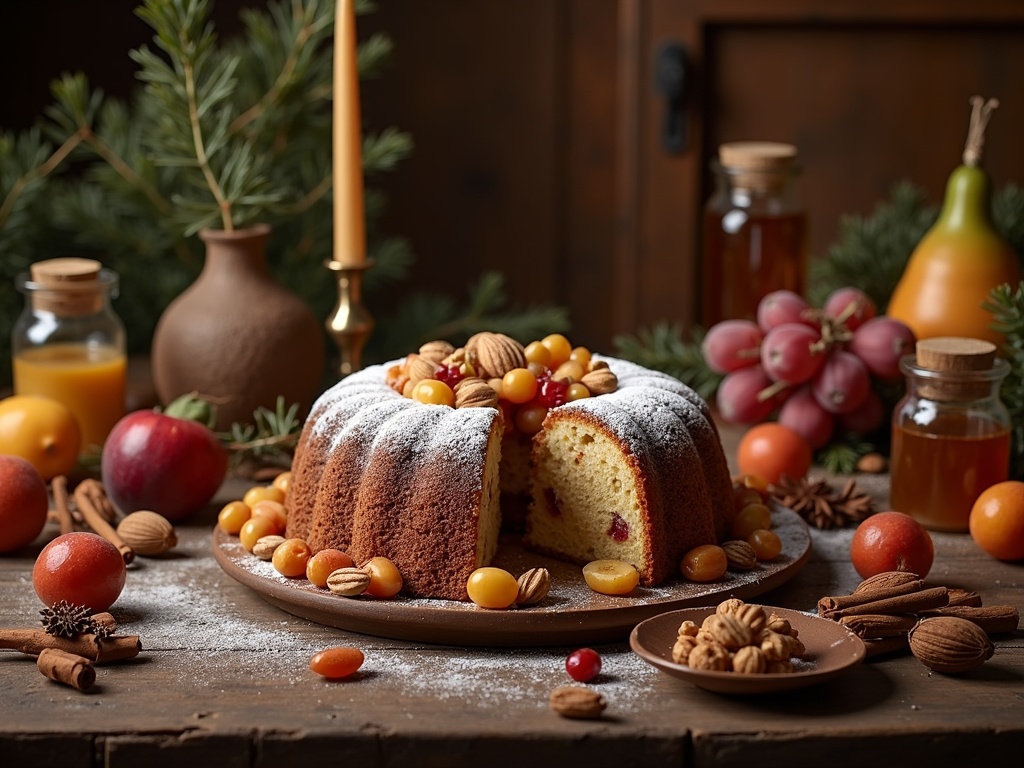
What Makes This Dense Fruit Cake Special
Panforte stands out in the world of confections with its distinctive characteristics that have made it beloved for centuries. I’ve found that this Italian specialty from Siena offers a unique eating experience unlike any other dessert.
Extraordinary Texture and Composition
The first thing you’ll notice about panforte is its remarkably dense and chewy texture. It shares similarities with nougat but has a personality all its own. When you bite into a slice, you’ll feel the satisfying resistance before it yields to reveal its complex character. This distinctive mouthfeel comes from the precise balance of ingredients and traditional preparation methods passed down through generations.
What truly sets panforte apart is its rich blend of premium ingredients. Each slice is packed with:
- Toasted nuts (typically almonds and hazelnuts) that provide crunch and earthy flavors
- Candied citrus peel and dried fruits that add chewy sweetness
- Honey that serves as a natural binding agent
- A warming spice mixture featuring cinnamon, cloves, and nutmeg
- Just enough flour to hold everything together
The limited amount of flour used gives panforte its characteristic density, while the high proportion of fruits and nuts creates its substantial, satisfying texture. These ingredients work together to create a luxurious Italian dessert that feels indulgent with each bite.
Cultural Significance and Preservation
Panforte isn’t just delicious—it’s culturally significant. This Tuscan specialty has earned protected status as a regional Italian food treasure. The designation “Panforte di Siena IGP” (Protected Geographical Indication) ensures that authentic panforte must be produced within specific areas around Siena following traditional methods and ingredients.
This protection isn’t merely bureaucratic—it preserves centuries of culinary tradition and guarantees consumers are getting the genuine article. When you enjoy a slice of authentic panforte, you’re participating in a food tradition dating back to medieval times. The dense festive cake was originally created as a form of tax payment to monasteries and clergy.
I find it fascinating that today’s panforte remains remarkably similar to its historical versions. The traditional preparation involves heating honey with sugar to form a hot syrup that binds the dry ingredients. This method creates not only the signature texture but also contributes to another remarkable quality: its impressive shelf life.
One of panforte’s most practical features is that it can be stored for several months without spoiling. The high sugar content, low moisture, and presence of spices all act as natural preservatives. This made it valuable in times before refrigeration and explains why it became a popular provision for travelers and sailors. Even today, you can purchase panforte and enjoy it gradually over weeks or even months—though I find it’s usually too tempting to last that long in my kitchen!
This fruit-filled cake shines during the Christmas season but deserves appreciation year-round. Its concentrated flavors mean a small slice satisfies, making it perfect with coffee or a sweet wine. The complex blend of nuts, fruits, and spices creates a taste experience that varies slightly with each bite, keeping your palate engaged and delighted.
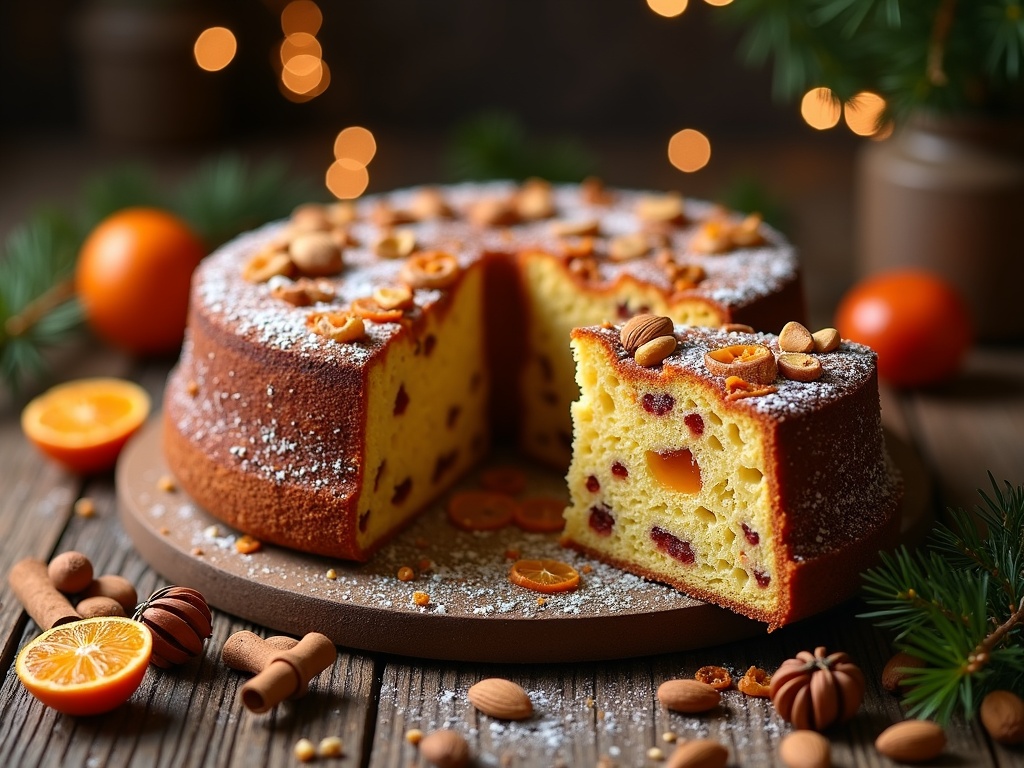
Essential Ingredients for Your Panforte
The magic of panforte lies in its rich combination of nuts, fruits, spices, and sweeteners. This Italian Christmas treat from Siena demands quality ingredients to achieve its characteristic dense, chewy texture and complex flavor profile. Let me walk you through the essential components that make this festive dessert truly special.
Nuts and Fruits: The Foundation
Hazelnuts and almonds form the backbone of any authentic panforte. I prefer using whole nuts that have been lightly toasted to enhance their flavor. The nuts should be roughly chopped—not ground—to maintain texture in each bite. For a traditional version, aim for equal parts of both nuts, comprising about 30-40% of your total mixture.
Candied citrus peel adds a bright, zesty punch that cuts through the richness. Orange and lemon peels are the most common choices, though some recipes include candied ginger for extra warmth. Quality matters here—homemade or premium store-bought candied peels will significantly elevate your homemade Italian dessert.
Dried fruits introduce natural sweetness and chewy texture. Figs bring a honey-like flavor with their tiny seeds adding pleasant crunch, while dates contribute caramel notes and moisture. These dried fruits should be finely chopped to distribute evenly throughout the mixture. Consider these alternatives based on your taste preferences:
- Dried apricots for tanginess
- Dried cherries for tartness
- Raisins for traditional sweetness
- Dried cranberries for color and acidity
Sweeteners and Binding Agents
Honey and sugar work together to create panforte’s distinctive texture. I use a combination of clear honey and granulated sugar heated together to form a syrup. This not only sweetens the cake but acts as the primary binding agent. The proportion matters—too much makes the cake sticky, while too little results in a crumbly texture.
All-purpose flour might seem insignificant in quantity compared to other ingredients, but it’s crucial for binding everything together. Just enough flour (typically 1/2 cup for a standard recipe) helps absorb moisture from the honey and fruits while giving structure to the festive Christmas cake.
The spice blend is what gives panforte its signature aromatic quality. Traditional winter spices include:
- Cinnamon (1-2 teaspoons)
- Nutmeg (1/4-1/2 teaspoon, freshly grated if possible)
- Cloves (1/4 teaspoon, ground)
- Coriander (1/4 teaspoon, optional but traditional)
- Black pepper (a pinch, for subtle heat)
Cocoa powder adds depth and complexity rather than making the panforte overtly chocolatey. Use Dutch-processed cocoa for a smooth, rich flavor without acidity. For a darker, more intense version like Panforte Nero, increase the cocoa powder to about 3-4 tablespoons per recipe.
The beauty of panforte lies in its adaptability. While respecting the traditional ingredient ratio (roughly 3:3:2:1 of nuts:fruits:sugar/honey:flour by weight), you can adjust the spice levels and specific dried fruits to suit your taste. Some modern interpretations even incorporate coffee, dark chocolate pieces, or a splash of orange liqueur.
For an egg-free cake option that still delivers satisfaction, panforte fits the bill perfectly as traditional recipes don’t use eggs. The combination of honey, sugar, and minimal flour creates a dense, satisfying texture that keeps well for weeks—making it perfect for holiday gift-giving or enjoying throughout the festive season.
Step-by-Step Preparation Guide
Preparing panforte might seem challenging at first, but I’ve broken it down into simple steps that make this Italian Christmas specialty approachable for home bakers. The key to a perfect panforte lies in the careful preparation of ingredients and attention to timing during the baking process.
Preparing the Core Elements
Toasting the nuts brings out their essential oils and deepens the flavor profile of your panforte. I start by spreading almonds, hazelnuts, and sometimes pistachios on a baking sheet and toasting them at 325°F (165°C) for 8-10 minutes until fragrant. After cooling slightly, I roughly chop them—leaving some pieces larger for texture contrast. This simple step creates that characteristic crunch that makes traditional Italian desserts so satisfying.
The dried fruit preparation requires careful attention. I mix chopped candied orange peel, candied citron, and dried figs in a large bowl. Then I add the warm spice mixture—typically cinnamon, cloves, nutmeg, and the distinctive touch of black pepper. For a more complex flavor, I’ll sometimes include cardamom or coriander. These spices need to be thoroughly distributed throughout the fruit mixture to create that classic panforte taste.
Creating the honey-sugar syrup forms the binding agent that holds everything together. In a heavy saucepan, I combine honey and sugar over medium heat, stirring constantly until the sugar dissolves completely. This mixture needs to reach exactly 240°F (115°C) on a candy thermometer—the soft-ball stage—for perfect consistency. I’ve found that rushing this step often leads to a panforte that’s either too soft or too brittle, so patience pays off here.
The next critical moment comes when combining the dry and wet ingredients. Once the honey-sugar syrup reaches temperature, I quickly pour it over the fruit-nut-spice mixture and stir vigorously. This step requires speed and strength—the mixture becomes quite stiff almost immediately. I make sure every dry bit gets coated with the syrup, creating a cohesive mass that will hold its shape during baking.
The baking process for panforte differs from most Christmas cake recipes. I preheat my oven to a moderate 300°F (150°C) and prepare a springform pan by lining it with edible rice paper or parchment paper. After transferring the dense mixture to the pan, I use slightly wet hands to press it into an even layer—typically about 1/2 inch thick for authentic texture.
Proper baking time is crucial—typically 30-35 minutes until the surface feels firm but still slightly soft in the center. Unlike most baked goods, panforte shouldn’t rise or change color significantly. I’ve learned to look for subtle signs of doneness: a slight darkening at the edges and a set texture that springs back slightly when touched.
The cooling phase requires patience. I allow the panforte to cool completely in its pan, which usually takes several hours. This waiting period allows the flavors to meld and the texture to firm up properly. Only after complete cooling do I dust the surface generously with powdered sugar, which adds both sweetness and that snow-covered appearance typical of holiday fruit cakes.
For the best flavor development, I’ve found that panforte actually improves after being stored for a few days in an airtight container. The spices intensify and the texture becomes perfectly chewy yet firm. When properly made and stored, this Italian delicacy can last for weeks, making it an ideal make-ahead treat for holiday gatherings or thoughtful homemade gifts.
Common Mistakes to Watch Out For
I’ve made panforte dozens of times, and through plenty of trial and error discovered the pitfalls that can turn this delicious Italian confection into a disappointing experience. Avoiding these common mistakes will help ensure your panforte turns out perfect every time.
Sugar Syrup and Ingredient Preparation Issues
Overcooking the sugar syrup is perhaps the most critical mistake to avoid. When the syrup cooks too long, it hardens quickly upon mixing with dry ingredients, making the dough difficult to work with and resulting in an overly firm final product. I aim for a syrup that reaches 240°F (115°C) – the soft ball stage – which creates the perfect chewy yet firm texture once cooled.
Not chopping ingredients finely enough can ruin the texture of your panforte. While this traditional Italian fruit dessert should have noticeable bits of fruit and nuts, pieces that are too large create an uneven texture and make cutting difficult. I recommend:
- Dice dried fruits to roughly 1/4-inch pieces
- Chop nuts coarsely but evenly
- Ensure candied citrus peel is finely diced
- Process harder ingredients like almonds slightly finer than softer ones
Technical Execution Errors
Using the wrong pan size significantly affects the final result. A pan that’s too large creates a thin panforte that dries out quickly, while one that’s too small results in a thick cake that may not cook through properly. I’ve found that an 8-inch springform pan works perfectly for most recipes, creating that classic 1-inch thick disc that characterizes a traditional Christmas fruit cake alternative.
Incorrect oven temperature is another sneaky culprit behind failed panforte. The traditional sweet requires a moderate oven (around 300°F/150°C) to gently bake without burning the sugars and nuts. Higher temperatures burn the edges before the center sets properly, while lower temperatures fail to develop the subtle caramelization that gives panforte its complex flavor profile.
I’ve also found that unmolding the panforte too soon can cause it to lose its shape. Letting it cool completely in the pan gives the honey and sugar mixture time to set properly, ensuring your fruit-filled dessert holds together beautifully when sliced.
Watch out for uneven distribution of ingredients – proper mixing ensures every bite contains the perfect balance of fruits, nuts, and spices that makes panforte so special. Taking time with each step leads to a memorable treat that’s worth the effort.
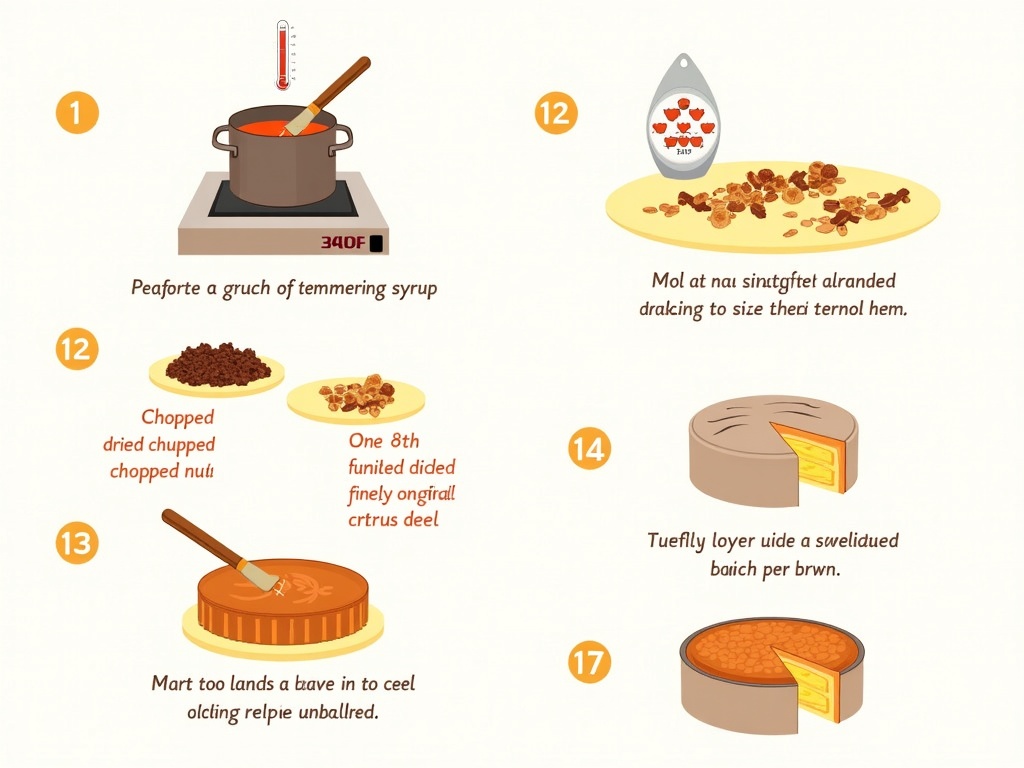
Expert Tips for Perfect Panforte
Crafting the perfect panforte requires attention to detail and a few key techniques that can transform this traditional Italian dessert from good to exceptional. I’ve gathered some expert tips that will help you master this dense, chewy fruit and nut confection that’s perfect for special occasions.
Essential Techniques for Superior Results
Lining your pan correctly creates the foundation for a beautiful panforte. I recommend using edible rice paper as a base layer in your baking pan. This traditional method not only prevents sticking but also creates that authentic finish around the edges of your panforte. The rice paper becomes part of the dessert, adding a subtle texture that complements the dense filling.
Temperature control makes all the difference when working with the sugar syrup that binds panforte together. I always use a candy thermometer to ensure the syrup reaches exactly the right consistency—typically around 240°F (115°C). This precision prevents the mixture from becoming too hard or remaining too soft after cooling, giving you that perfect chewy texture that signature Italian desserts are known for.
The quality of ingredients directly impacts your final product. I select high-quality dried fruits with vibrant color and soft texture—never the hardened, dull varieties that have been sitting on shelves too long. Premium nuts with fresh, clean flavor profiles will elevate your panforte dramatically. This is especially important when making panforte as a festive Christmas treat, when you want the flavors to truly shine.
Proper storage techniques preserve your panforte’s flavor and texture. After cooling completely, I wrap it tightly in parchment paper and store it in an airtight container. This prevents the confection from drying out while allowing the flavors to develop and meld together over time. A metal tin works particularly well for this purpose.
Aging your panforte isn’t just traditional—it’s transformative. I’ve found that allowing your panforte to mature for at least a week before serving creates a remarkable difference in flavor complexity. The spices become more pronounced, the fruit flavors deepen, and the texture reaches that perfect balance between chewy and firm. Some traditional fruit cake recipes follow similar aging principles for enhanced flavor.
Consider these additional points when preparing your panforte:
- Toast nuts before adding them to intensify their flavor and create better overall depth
- Chop ingredients to uniform sizes for consistent texture throughout
- Dust your knife with powdered sugar between cuts for clean slices
- Serve thin wedges as panforte is quite rich and dense
- Experiment with different spice blends like anise, coriander, or cardamom to create your signature version
The proper mixing technique also plays a crucial role. I fold the heated honey-sugar mixture into the dry ingredients quickly but thoroughly, working fast before it starts to set. This creates that perfect binding without making the mixture too stiff to work with.
For a modern twist on this classic, I sometimes add interesting flavor combinations like dried cherries with pistachios or apricots with almonds. These variations maintain the spirit of traditional panforte while offering exciting new flavor profiles, similar to how Black Forest gateau reinterprets classic chocolate cake.
With these expert techniques, you’ll create a panforte worthy of gift-giving or centerpiece status at your holiday table. The combination of rich flavors, chewy texture, and beautiful presentation makes this Italian specialty worth the effort to perfect.
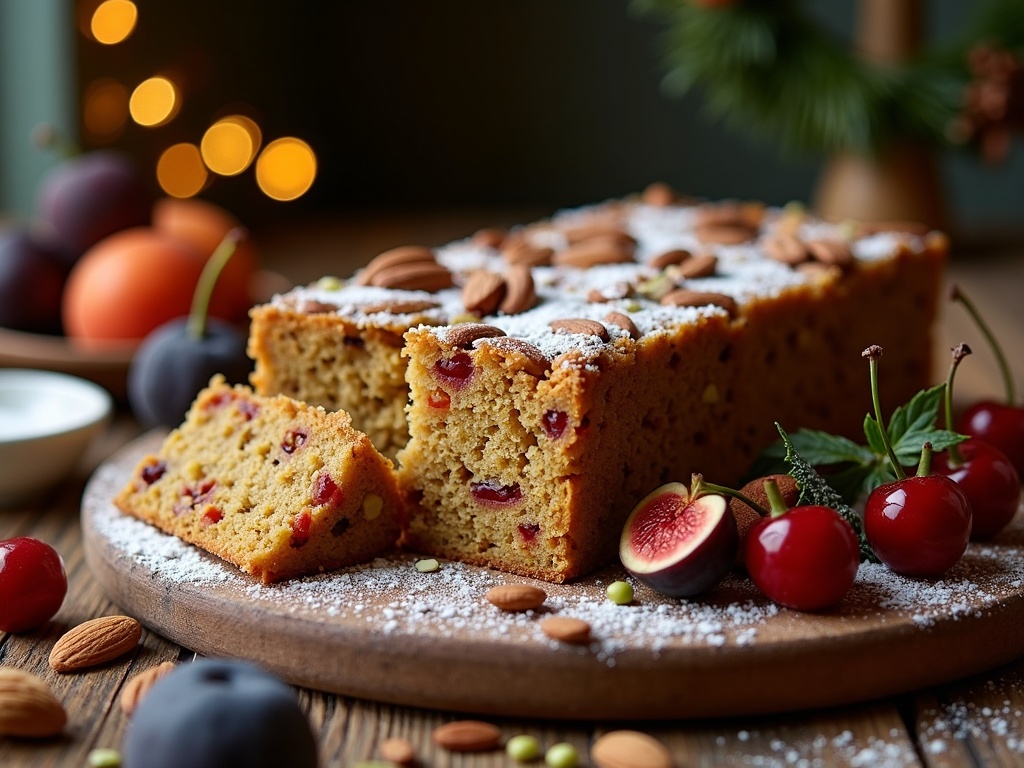
Serving and Storage Suggestions
Panforte makes a stunning addition to any dessert table with its rich flavors and dense texture. Traditional Italian serving sizes for panforte are quite modest – typically cut into small wedges or thin slices of about 1-2 inches. This makes perfect sense given the concentrated flavors and richness of this classic Italian dessert that packs a punch with every bite.
Temperature and Pairing
I’ve found that panforte tastes best when served at room temperature, which allows its complex flavors to fully develop. If you’ve stored it in the refrigerator, I recommend taking it out about 30 minutes before serving. This dense fruit and nut confection pairs beautifully with:
- Strong coffee or espresso, creating a perfect balance with the sweet spices
- Sweet dessert wines like Vin Santo or Moscato
- A small glass of grappa or amaretto liqueur
- Alongside a festive holiday cake as part of a dessert platter
When it comes to storage, panforte’s high sugar and honey content acts as a natural preservative. To maintain freshness, I wrap mine tightly in parchment paper first, then in aluminum foil or plastic wrap. For extended storage, place it in an airtight container. If your kitchen gets particularly warm, storing in the refrigerator is a good option.
Properly stored, panforte can last an impressive 2-3 months at room temperature and up to 6 months in the refrigerator. The flavors actually mature and improve over time, making it an excellent treat to prepare in advance for special occasions.
Panforte makes a thoughtful gift, especially during the holiday season. For gift-giving, I like to wrap individual panforte in decorative parchment paper tied with twine or ribbon. For an extra special touch, place it in a decorative tin or wooden box with a handwritten note about its origins and ingredients. Some traditionalists even dust the top with a light coating of powdered sugar right before packaging, creating a beautiful snowy effect that’s particularly festive.
A small panforte nestled among other Italian treats like biscotti and torrone creates an impressive gift basket that’s sure to delight any food lover. The dense texture and sturdy nature of this fruit-filled specialty make it perfect for shipping to distant friends and family.
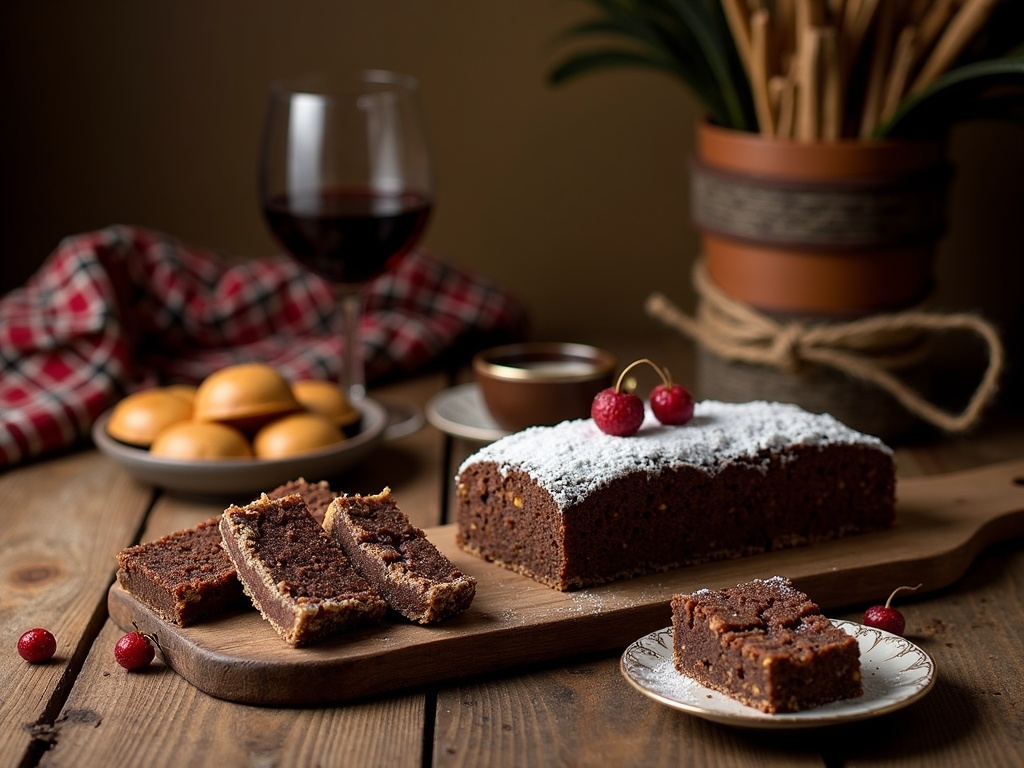
Modern Variations to Try
I’ve experimented with countless panforte recipes over the years and discovered some exciting modern twists on this classic Italian dessert. Traditional panforte contains nuts, dried fruits, and spices, but contemporary versions push the boundaries while maintaining the rich, dense texture that makes this treat so special.
Chocolate and Nut Innovations
Chocolate has become a game-changer in modern panforte creations. I’ve found that adding dark chocolate chips directly into the honey mixture creates pockets of melted goodness throughout the cake. For a more intense experience, try replacing some of the flour with cocoa powder or finishing with a chocolate ganache drizzle over the top.
When it comes to nuts, why stick with just almonds? These alternative options add unique flavors and textures:
- Pistachios for their vibrant green color and delicate flavor
- Hazelnuts for a richer, more robust nutty profile
- Macadamias for buttery sweetness
- Brazil nuts for an unexpected tropical twist
I’ve discovered that toasting the nuts before adding them intensifies their flavor profile dramatically. For a truly indulgent variation, try caramelizing the nuts separately before incorporating them into your Christmas dessert recipe.
Fruit Substitutions and Dietary Adaptations
Traditional panforte contains candied citrus peel, but I’ve successfully experimented with numerous dried fruit alternatives:
- Dried cherries add a pleasant tartness
- Apricots bring a sunny sweetness
- Cranberries provide festive color and zing
- Figs contribute a honey-like sweetness and interesting texture
For a tropical twist, I sometimes add dried mango or pineapple to create a fusion version of this Italian classic. These exotic fruits pair surprisingly well with the warm spices in a traditional fruit cake base.
Making panforte accessible for everyone has led to excellent gluten-free adaptations. I’ve had great success substituting regular flour with almond flour or a pre-mixed gluten-free blend. The dense nature of panforte means it doesn’t rely on gluten development for structure, making it an ideal candidate for gluten-free baking.
For those with nut allergies, sunflower or pumpkin seeds can replace traditional nuts while maintaining that essential crunch. The key is maintaining the proper ratio of dry to wet ingredients, so the final product has that characteristic chewy texture that makes authentic desserts so irresistible.
I’ve found that while modernizing this ancient recipe, it’s important to keep the essential spice blend intact – cinnamon, nutmeg, and cloves are non-negotiable elements that give panforte its distinctive flavor profile regardless of other variations.

